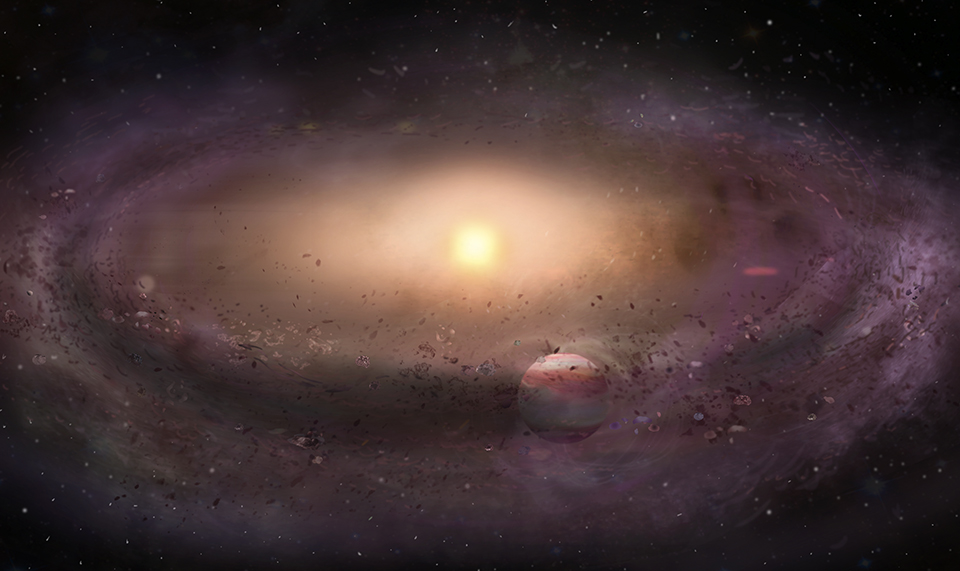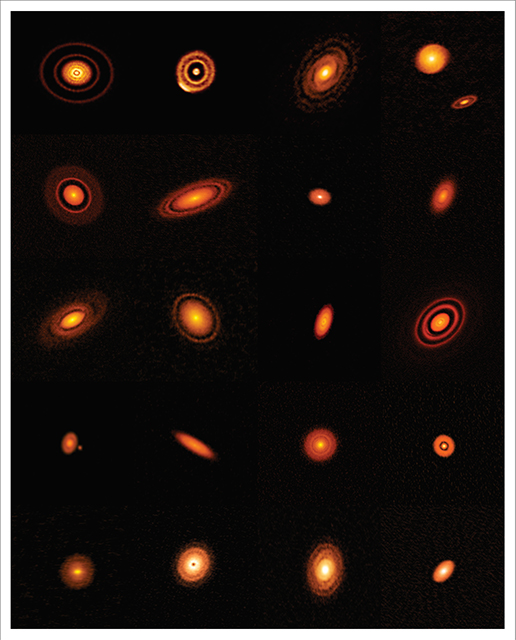Images of Stars Offer Rare Insight into the Formation of Planets

The National Radio Astronomy Observatory announced today the survey of the protoplanetary disks offer insight into the birth of new planets and the formation of solar systems. Among the researchers was CSUN astrophysicist Luca Ricci. Above is an illustration by CSUN assistant professor of art Erik Mark Sandberg depicting what the researchers found.
New images taken by a team of researchers that included California State University, Northridge astrophysicist Luca Ricci offer insight into the birth of new planets and the formation of solar systems, including our own.
Using the Atacama Large Millimeter/submillimeter Array (ALMA) telescope in Chile, Ricci and his colleagues captured the clearest images yet of 20 young stars in various stages of “giving birth” to planets.
“Until a few years ago, no one thought we would be able to detect the signature of a protoplanet — a large body of matter in orbit around a young star and thought to be developing into a planet — let alone 20,” said Ricci, an assistant professor in CSUN’s Department of Physics and Astronomy. “No one thought we could see the rings around young stars that indicate planets are forming right there. We’re not talking about one star, we’re talking about 20 different stars. Some of them are quite young, about a million years old, or five thousand times younger than our sun, and they have evidence of planets forming around them. You could call them nurseries of new planets.”

Using the Atacama Large Millimeter/submillimeter Array (ALMA) telescope in Chile, CSUN astrophysicist Luca Ricci and his colleagues captured the clearest images yet of 20 young stars in various stages of “giving birth” to planets. Photo courtesy of the National Radio Astronomy Observatory
Ricci said the new images were “a gold mine of information.”
“The better the definition of the images we can get for the material surrounding young stars, the more information we can get about how planets and solar systems are formed,” he said, “and the more information we get about how our own planet and solar system were formed.”
The National Radio Astronomy Observatory announced the survey of the protoplanetary disks today. Ricci and his colleagues’ workwill appear in a special focus issue of the Astrophysical Journal Letters.
Ricci said that until 2015, even the most powerful telescopes in the world were not capable of providing a clear picture of what exactly was happening around young stars.
“It was basically a blob,” he said. “It was a big blob of bright light that illustrated the star and the planets-forming material inside of it. It was even bigger than our solar system. It was very likely that something of this kind generated another solar system, but we could not find clear evidence of it. We had to make a supposition based on what we already knew.”
Then, in 2015, researchers used the ALMA telescope to take a new image of a young star and its rings being shaped by the gravity of baby planets. ALMA is currently the world’s most powerful observatory for studying the universe at the long-wavelength millimeter and submillimeter range of light. It is designed to spot some of the most distant galaxies ever seen, and to probe the areas around young starts for planets in the process of forming.
“With this new picture, we got to actually see the rings and dark gaps between the rings formed by the young planets and their gravity as they pull on material, dust particles and gas, as they grow and get bigger,” Ricci said. “But it was one image and one young star. While we learned so much from that one image, it raised questions about what we can learn if we have images of more stars.”
Ricci and his colleagues used ALMA from May to November 2017 to capture images of 20 different young stars, and all of them showed signs of planets being formed around them.
“In some cases, you can actually see the spirals around the stars, and even a large bump in one of the stars’ rings, likely indicating protoplanetary activity,” he said.

CSUN astrophysicist Luca Ricci. Photo by Lee Choo.
“Twenty stars surrounded by disks tell us that planetary systems like our own are forming out there,” Ricci said. “A planetary system like our own, if you look at it now, where everything seems kind of calm. You have planets traveling in space. They’re silent. They don’t interact with other planets in the system. They just keep orbiting the sun. In some ways, we’re in a pretty inactive system.
“But with these stars,” Ricci said, “they have a lot of material in their disks. All these planets are interacting with their environment. What we think is going on is that by interacting with their environment, the planets change. They are growing. They are going into orbit. Some are moving toward the star. Some are moving away from the star. Some of these young planets can interact with each other. This is the first time that we can start studying the features of all these interactions in real systems, and it is out of these interactions that the architecture of thatplanetary system will be formed, much like what happened with our own solar system.
“The architecture of our solar system was defined by what was going on with our own protoplanetary disks 4.5 billion years ago,” he said, “and now we’re seeing the same phenomenon going on right now hundreds of light years from us.”
Ricci said the images they captured will provide a new set of resources for researchers across the world.
Ricci already has his eye on the potential for new images and possible discoveries from the Next Generation Very Large Array (NGVLA) telescope. Though still in the planning stages, Ricci said that when the new telescope is up and running in about 10 years, it will have the ability to directly image the formation of Earth-like planets, trace the complex organic molecules in star-forming regions, probe the dense gas history of the universe during the epoch of galaxy assembly, detect pulsars in our galaxy, and much more.
“You saw the images that we captured with ALMA; the possibilities of what we can see with this new telescope are mind blowing,” he said. “This is one fascinating aspect of scientific research: the more learn, the more you want to learn. Learning about the universe makes our desire to understand everything grow more and more without an end.”
Ricci’s fellow researchers included Sean M. Andrews, Jane Huang,Karin I. Öberg and David J. Wilner of the Harvard-Smithsonian Center for Astrophysics; Xue-Ning Bai of the Institute for Advanced Study and the Tsinghua Center for Astrophysics at Tsinghua University in China; M. Benisty of the Unidad Mixta Internacional Franco-Chilena de Astronomía, the Departamento de Astronomía at the University of Chile and the Université Grenoble Aples in France; T. Birnstiel of the Ludwig-Maximilians-Universität München, Germany; John M. Carpenter and V.V. Guzman of the Joint ALMA Observatory in Chile; C.P. Dullemond of the Center for Astronomy at Heidelberg University, Germany; A Meredith Hughes of the Van Vlack Observatory in the Department of Astronomy at Wesleyan University; Andrea Isella and Erik Weaver of the Department of Physics and Astronomy at Rice University; Laura M. Pérez and Nicolás Troncosco of the Departamento de Astronomía at the University of Chile;and Shangjai Zhang and Zhaohuan Zhu of the Department of Physics and Astronomy at the University of Nevada, Las Vegas.

A closer look at four the young stars in various stages of “giving birth” to planets. Photo courtesy of the National Radio Astronomy Observatory.

 experience
experience